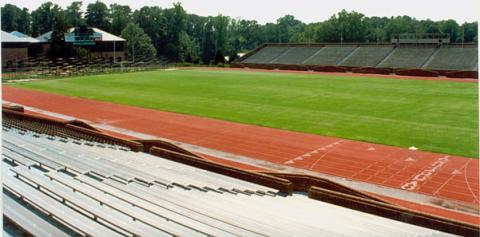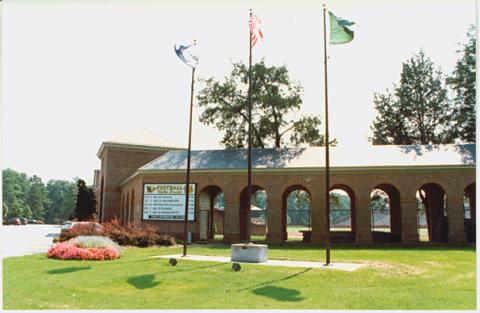Zable Stadium is William & Mary's main football and track and field venue. Before its dedication as Zable Stadium in 1990, it was known as Cary Field or Cary Field Stadium or William & Mary Stadium (unofficially). It is located between the Sadler Center and the Alumni House. The Jimmye Laycock Football Center is next to the stadium. The formal address is 100 Stadium Drive. The north end of the stadium faces Richmond Road.

Constructed: 1907-1909, 1935 (stadium)
Named for: T. Archibald Cary
Renovated: 1921, 1927, 1979-1980
Map it for me
Cary Field Era
Cary Field, now the location of Zable Stadium, was originally named to honor T. Archibald Cary of Richmond and his father, John B. Cary. Father and son were members of the Board of Visitors, and John B. Cary served a Confederate officer during the Civil War. T. Archibald Cary donated $1,000 to William & Mary for athletics via a letter dated January 4, 1907 (Folder "Buildings and Grounds, 1907-1911," Office of the President, Lyon G. Tyler Records). In another letter to the president dated October 19, 1907, Cary noted the grounds were still not ready despite his gift. The new, enclosed field was completed in time for baseball season in 1909. In 1909, Cary had donated a total of $2665.00 to the effort. About $170 was appropriated to paint and stain the grandstand and fence of the newly named Athletic Field that same year. In 2021, the Board of Visitors, as part of a comprehensive review of building names on campus, determined that the honorific for Cary Field shall henceforth be for T.A. Cary alone.
Board of Visitors Excerpts
February 9, 1909
"The following was adopted,
"That the thanks of the Board be extended to Mr. T.A. Cary of Richmond, a former member of this body, for his generous gift of $2665.00 to the College in the interest of athletics.
"That the athletic field be named the Cary Athletic Field in honor of the Donor and his distinguished Father John B. Cary, an esteemed alumnus of the College and former member of the Board."
2021
“Over the past decade, the Board of Visitors and two William & Mary presidents have
determined that William & Mary’s usual practices in campus building names and iconography shall
not celebrate the Confederacy nor those who upheld Confederate tenets and racist ideology,
defending the institution of slavery and secession from the United States.
“Review of such building names at William & Mary happens in a methodical and
conscientious way that takes into consideration multiple factors, including actions throughout a
person’s life, consistent with the design imperatives and principles of naming and renaming
approved by the Board of Visitors in September, 2020.
“…the honorific [for Cary Field] shall be for T.A. Cary alone. T.A. Cary’s
gift to William & Mary created the first football field on which so many distinguished coaches
led William & Mary teams and gridiron legends played.”
1910s-1920s
Repairs to the grandstand at Cary Field in 1910 cost about $100. A cinder track for the field was constructed in 1921, and a gift of a new scoreboard on the left field from Prof. and Mrs. Frederick Juchhoff replaced an earlier makeshift scoreboard on the centerfield fence. Bright Farm was purchased by the College in October 1923 and served as a new athletic field adjoining Cary Field, with a 1/4 mile cinder track with 220 yard straightaway, two football gridirons, and two baseball diamonds.
In 1927, electric lights were used on the field, and grandstands changed from one line of stands along the west side of the field to a horseshoe arrangement taking in the north, west, and east sides. Some sections were as high as 14 rows, and seated approximately 5000 people.
Plans were made in 1928 for a freshman athletic field to be located on west side of Cary Field. The old grandstand on the baseball field was torn down as it was condemned as unsafe. Instead, the bleacher stands from the football field were to be used.
Stadium Construction
In 1935 J. Binford Walford, the College Architect, drew plans for a new stadium. The plans were for a concrete stadium faced with brick that would be dedicated in September that same year. There would be space for a ladies' lounge, locker rooms, showers, field room, storage, wash rooms, and a heating plant below the seats of the east section. There would also be space under the west section just for storage. While William & Mary petitioned the Public Works Administration for funding to construct a number of buildings on campus, tax-payer dollars could not be used for the construction of athletic facilities. Rumors still persist to this day that in order to secure funding, William & Mary masqueraded the construction of the football stadium as an agricultural exposition or amphitheater.
Fire
A fire in 1948 on the left side of the stadium burned for two hours and cracked the concrete under the stand. However, the damage to the stadium was not too serious.
Stadium Expansion Controversy
In the 1970s there were demands from some football supporters and members of the Board of Visitors to expand the stadium further to seat 30,000 and secure a place for the university as a "big-time" athletic program. Williamsburg residents, students, faculty, staff, and alumni worked against the expansion including forming an opposition group, the Amos Alonzo Stagg Society. The outcry included boycotts of classes, rallies, the protest song "Ode to Cary Field" was written by a student, a Save the Charter Day event, a lawsuit, and other actions. Polls revealed 87% of students and 92% of faculty opposed further expansion of the stadium, but the Board continued to push for stadium expansion. The need for a larger stadium became a moot point after 3 years of discord when in December 1981 the NCAA lowered William & Mary from Division I-A to I-AA in football.
In 1979, the stadium underwent a $1 million renovation which raised seating capacity to 15,000, disposed of the original wooden bleachers, repaired masonry, crowned the field, and improved locker and equipment rooms.

Named for: Walter J. Zable
Map it for me
Zable Stadium Era
In 1990, the stadium finally received a formal name - Walter J. Zable Stadium - in honor of a $10 million pledge to William & Mary's Campaign for the Fourth Century by Walter J., Class of 1937, president and chief executive officer of the Cubic Corporation, and his wife Betty C. Zable, Class of 1940. Walter Zable was a track and football star during his time at William & Mary. The stadium at Cary Field was named the Walter J. Zable Stadium by the Board of Visitors in his honor. The BOV approved the naming at their November 2, 1990 meeting. Of the total commitment, $5 million was designated to endow scholarships for William & Mary student athletes, $2.5 million would be used to endow graduate student aid, and the remaining $2.5 million to meet the needs of various university programs in the future.(William & Mary News, 7 November 2000, p. 1)
In 1996, the north gate facing Richmond Road was named the John Harvard Randolph '64 Alumni Gate.
In 2000, Walter & Betty Zable made a $6.8 million gift to refurbish the football stadium. (William & Mary News, 21 September 2000, p. 1)
Permanent lights were added in 2005 and artificial turf - "Field Turf" - was laid in 2006.
In 2013, "estate of the late Walter J. Zable '37, LL.D. '78 has provided a $23.9 million gift to William & Mary, $20 million of which will be split between scholarships for student athletes and renovations to the stadium that carries his name. The gift ranks among the largest single gifts in W&M's 320-year history." 1
In 2021, the arcade at Cary Field, the arched walkway on the northside of Zable Stadium, was named for Arthur A. Matsu, after the University's first Asian American student. Art Matsu ’27 played four sports at William & Mary, including football, at which he excelled. After graduating, he became the first alumnus to play in the NFL. He later coached football at Rutgers University. For more information, see W&M campus structures named for trailblazing alumni
Material in the Special Collections Research Center
- SCRC Collections Database: search by names, organization, subject, event, etc.
- Search the W&M Digital Archive for additional material.
- Colonial Echo: Photographs include 1913 p. 150, 1916 p. 152, and many others.
- Flat Hat
- University Archives Photograph Collection, Special Collections Research Center, Earl Gregg Swem Library, The College of William & Mary. including P1998.177 and many others.
- University Archives Subject File Collection, Special Collections Research Center, Earl Gregg Swem Library, The College of William & Mary.
- Athletics Department Records, Special Collections Research Center, Earl Gregg Swem Library, The College of William & Mary.
- Amos Alonzo Stagg Society Records, Special Collections Research Center, Earl Gregg Swem Library, The College of William & Mary
- William & Mary News, 4/24/96, p. 3; 10/16/96, p. 5.
- Search for Cary Field in the SCRC Collections Database.
References
- Office of the President, Lyon G. Tyler Records, Special Collections Research Center, Earl Gregg Swem Library, The College of William & Mary.
- William & Mary News: 7 November 1990; 21 September 2000.
